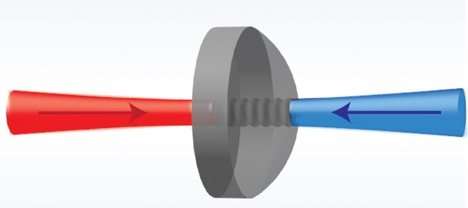Counter propagating laser light excites a long-lived sound wave inside a crystalline solid. Credit: Northern Arizona University
A new study published in Nature Physics describes how a team of scientists used a laser beam to gain access to long-lived soundwaves in crystalline solids as the basis for a potentially new approach to information processing and storage. One of Northern Arizona University's newest physicists, assistant professor Ryan Behunin, is a co-author of the study. In collaboration with scientists at Yale and the University of Rochester, he helped develop the theory describing these bulk crystalline optomechanical systems.
"Through an effect called 'Brillouin scattering,' an intense laser beam passing through a transparent medium can produce soundwaves as well as new colors of light," Behunin said. "This type of interaction between light and sound falls into a domain of physics called optomechanics. Within specially designed pristine crystalline systems at very low temperatures, Brillouin scattering can produce soundwaves that persist very long times, much longer than at room temperature.
"This phenomenon is intriguing because the longer a soundwave lives, the more useful it can be for things such as precision sensors—or for use with quantum computers, systems that can achieve exponential speeds over your desktop computer for certain types of calculations."
Acoustic technologies harnessing the power of sound are already critical elements of everyday technologies, from mobile phones to global positioning systems. As technology evolves and is able to harness the properties of quantum mechanics, scientists look to develop acoustic technologies for applications in fields such as quantum computing.
These acoustic devices have the potential for commercial application—a novel laser based on sound, for example, could enable new approaches to precision timekeeping in communications systems. Interactions between light and sound in specially engineered crystals could enable new devices for future quantum networks.
"We're very excited about the prospects for this work," Behunin said. "In the future we hope this system will enable searches for new physics, unique forms of precision sensing and novel approaches to quantum information processing."
More information: W. H. Renninger et al. Bulk crystalline optomechanics, Nature Physics (2018). DOI: 10.1038/s41567-018-0090-3
Journal information: Nature Physics
Provided by Northern Arizona University






















